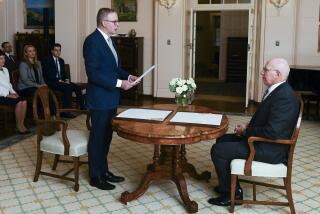Traveling About the Pacific Rim Shows Changes in the Works
- Share via
Australia is bidding g’bye to its immensely popular advertising campaign featuring actor Paul Hogan (“Toss another shrimp on the barbie”) this year.
The Australian Tourist Commission is yielding to a request by the actor to stop the 6-year-old campaign. Hogan did the commercials for free and went on to greater fame with Crocodile Dundee. He’s tired of the repeated use of the first commercial he did for Australia in 1984.
The campaign, which helped put Australia on the tourist map, will be a tough act to follow, especially now that Australia is battling back from a drop in tourism in 1989. The number of visitors to Australia fell to 2 million in 1989 from 2.25 million the year before, A. J. Thirwell, managing director of the Australian Tourist Commission, told the recent Pacific Asia Travel Assn. in Vancouver. Revenue from tourism--Australia’s No. 1 export earner--fell to about $4.6 billion ($6.1 billion Australian) from about $5 billion ($6.5 billion Australian) in 1988. Thirwell attributed the drop to a number of factors, especially a disruptive five-month strike by pilots of domestic Australian carriers.
Australian Greg Norman, who is ranked among the world’s top golfers, has offered to stand in for Hogan, but the commission hasn’t taken him up on the offer. Meanwhile, Australia is stepping up marketing efforts in Asia. In 1989, the biggest increases came in visitors from Japan and other parts of Asia, while the number of tourists from the United States and Europe fell.
Qantas to Drop Some Routes, Add Others
Qantas, Australia’s national airline, will drop four unprofitable routes later this year to focus on Asia, which the carrier believes will become a major source of tourists for the country.
“We are taking our resources from one part of the planet and putting them in another, much more profitable part of the planet,” said Rodger Robertson, director of corporate planning for Qantas.
By this fall, Qantas plans to stop flying to Amsterdam, Athens, Bombay and Bahrain. “These places are losing us money, and there’s very little prospect of them becoming profitable,” Robertson said.
Robertson said that by 2000 Asia would be Australia’s major source of tourists, with 2.4 million Asians entering the country annually, compared to 1.4 million tourists from Britain and Europe and 800,000 from the United States.
Currently, Europe and Britain are Australia’s biggest source of tourists, followed by New Zealand. “Asian tourism will grow much faster than everywhere else,” Robertson said.
Robertson said Qantas will add an extra four or five flights a week to Japan, a couple of extra flights to Singapore and Bangkok and establish one flight a week to South Korea. He said Qantas also hoped to start flying to Taiwan under a new subsidiary carrier Australia-Asia Airlines.
Tourism Industry Caters to ‘Greenies’
Environmental “greenies” take note: The tourist industry says it is mindful of its environmental responsibilities, from preserving the rain forests of Indonesia to concerns about the effect of exhaust from bigger aircraft on the ozone layer.
“It’s the green decade,” said Larry Helber, president of Helber Hastert & Kimura Planners of Honolulu. “We have to show that tourism is a friend of the greenies, the environmentalists.” He said it is commonplace in Hawaii now for project proposals that require zoning changes to take five to seven years to receive approvals. “That’s the real world.”
Preservation of the environment will be an issue comparable to earlier efforts to preserve and save the culture and heritage of other areas previously developed, tourist operators say. “Environmentally safe tours,” explained J. Patrick Clark Jr., president of Jetabout North America in Los Angeles, would take people to areas that are promoted as preserving the environment.
Japanese Media Skip Travel Conference
Considering that a record 10 million Japanese tourists are expected to travel worldwide this year, the Japanese media were curiously absent from the recent Vancouver gathering of the Pacific Asia Travel Assn. “It’s distressing to me; it’s the first time in 10 years we’ve only had one from Japan,” said Graham Hornel, PATA’s director of communication. He also noted it was the first time that PATA did not pick up the tab for the media.
Kiyomi Suzuki from the trade weekly Travel Journal was the sole Japanese reporter present. His boss, publisher Jim T. Moritani, attributed the no-shows to the fact that the conference was in English and to a general “lack of internationalization and awareness” on the part of the Japanese. “It’s kind of a demerit on the Japanese as a whole.”
South Korea Travel Is a Two-Way Street
The lifting of all travel restrictions by the South Korean government led to an explosive 67.3% increase--to 1.2 million--in Koreans venturing abroad in 1989. Meanwhile, 2.6 million foreigners visited South Korea in 1989, up 16.6% from the year before, according to Cho Young-Kil, president of Korea National Tourism Corp.
Visitors from Japan accounted for about 50% for the inbound tourists, followed by the United States with about 13%. Half of the Korean travelers visited Japan in 1989, while about 15% visited the United States.
Cho expects that 1.5 million Korean citizens will travel abroad, while 3 million foreigners will visit South Korea this year. Through February, the number of outbound tourists was up 40.2%, while the number of visitors were up 9.5%, Cho said.
More to Read
Sign up for The Wild
We’ll help you find the best places to hike, bike and run, as well as the perfect silent spots for meditation and yoga.
You may occasionally receive promotional content from the Los Angeles Times.






